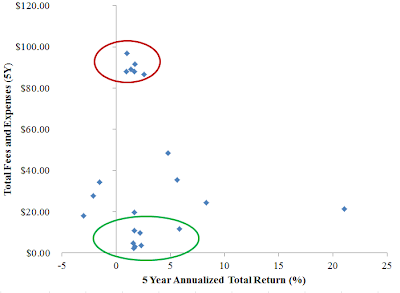A Primer on Investment Companies
(Mar 2012)
Investment companies are entities that issue securities and whose primary business is investing in securities. We have written about investment companies in several of our posts (See blog posts on ETFS and Mutual Funds). This post provides a quick introduction to investment companies and the securities they issue. The three main types of investment companies according to federal securities regulation are: closed-end funds, unit investment trusts, and open-end funds.
Some of the main...
Which Would You Rather Have?
(Mar 2012)
Last month we had a blog post introducing the FINRA Mutual Fund Expense Analyzer tool. In this post we apply it to the 25 largest mutual funds and ETFs measuredby net asset value using data from Morningstar. We assumed for this calculation an initial investment of $1,000 held for five years, and plot the total fees and sales charges over that period against the historical 5 year annualized total return of the fund:
There is no clear linear relationship between returns and fees as depicted in...
Time to Call for More Transparency in ETF Market
(Mar 2012)
Exchange-traded funds (ETFs) started as a "plain vanilla" product: a type of low-fee, tax-efficient mutual funds holding index-mimicking portfolios. The first ETF was formed by the Toronto Stock Exchange in the 1980s and has garnered spectacular popularity in recent years. According to a recent article in The Economist, the number of ETFs in America has almost tripled from its 2006 level of 343 to 1,098 in December 2011. This volume increase has been accompanied by substantial financial...
Mutual Fund Expense Analyzer: A Tool for Calculating Mutual Fund Fees and Expenses
(Feb 2012)
Every mutual fund investor should know how important fees and expenses are in determining the net return of his investment. Compared with other factors affecting a mutual fund's or an Exchange Traded Fund (ETF)'s return, such as market returns, fees and expenses are more stable over time and it is therefore easier to predict their effect on a fund's future performance. However, comparing fees and expenses across funds can be tedious and confusing, as different funds can use different fee...
Futures-Based (Commodities) ETFs
(Jan 2012)
Investors may think, when investing in Futures-Based Commodities exchange traded funds (ETFs), that they are gaining exposure to the underlying commodity. In this blog post, we discuss the ability of these ETFs to track the spot price of the underlying commodity.
In a previous blog post, we introduced the basics of Exchange Traded Funds (ETFs). In this post, we are going to discuss a specific kind of ETF: Commodities Futures Based ETFs.
There are a large number of Exchange Traded Funds...
What are 'structured products', anyway?
(Jan 2012)
By Tim Husson, PhD
We've done a lot of work on structured products. And I mean a lot. In addition to our research on valuation and suitability issues, we've devoted a section of our website to informing investors about different types of products, as well as Tear Sheets evaluating several thousand structured products released over the past couple years. We have found that most structured products are issued at a substantial premium, and that many investors (especially retail investors) do...

